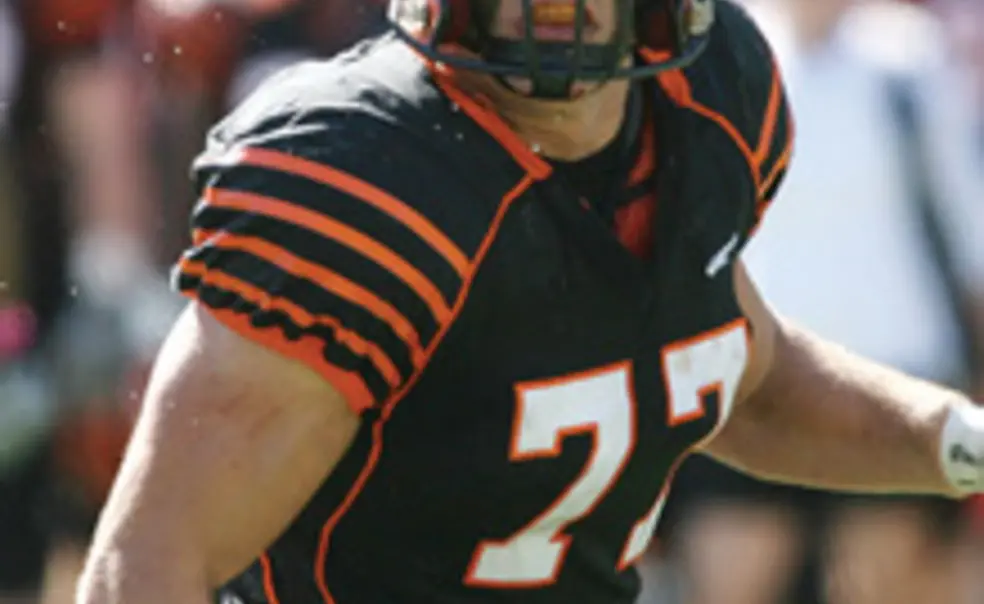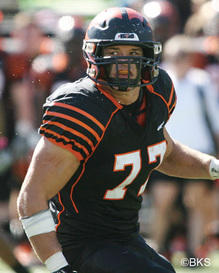Former pros discuss the road ahead for NFL draftee Catapano '13
As a high school football player in Bayville, N.Y., Mike Catapano ’13 believed he could play in the NFL someday. He kept that goal even after choosing to attend Princeton, where only one player had been drafted in the previous two decades. And on Saturday, Catapano’s dream became reality, as he was selected by the Kansas City Chiefs with the first pick of the seventh round in the 2013 NFL Draft.
Mike Catapano '13, chosen in the seventh round by the Kansas City Chiefs, was Princeton's first NFL draft pick since 2001. (Photo: Beverly Schaefer)
Catapano became the first Princetonian taken since Dennis Norman ’01 in 2001, and as the 201st overall pick, he is the Tigers’ highest selection since Jon Schultheis ’83 was the 182nd pick 30 years ago. But for Catapano, being drafted is only the beginning — now, he’ll have to show the Chiefs’ coaching staff that he deserves to play at the highest level.
The very first practices will be crucial for Catapano, especially as a late-round pick from the Ivy League. Catapano performed well in January’s East-West Shrine Game, a showcase for some of the nation’s top draft prospects, but he still hasn’t been tested as often as some peers from major conferences. “As a seventh-round pick, he’s not guaranteed anything other than his signing bonus,” said Ross Tucker ’01, who played for five NFL teams in seven seasons as an offensive lineman and now works as a pro and college football analyst. “First impressions mean a lot — he’s going to have to show that the level of competition is not too much.”
Princeton head coach Bob Surace ’90, an assistant coach with the Cincinnati Bengals from 2002-09, said all rookies are scrutinized carefully in their first practices, which are usually technique-oriented and conducted without pads. The most important thing a player can do to impress his new coaches, however, is to carry himself like a professional. “Mike will exceed expectations in terms of being on time, being accountable, learning the playbook and all that,” Surace said.
Catapano has already shown he has the physical skills to compete at the NFL level. At Princeton’s pro day last month, the senior bench-pressed 225 pounds 33 times and ran the 40-yard dash in 4.75 seconds, both above-average marks for his position. Still, nearly all former players say the speed of the game is much faster in professional football, and it takes time to get used to that transition.
Kansas City head coach Andy Reid said he plans to use Catapano as an outside linebacker in the Chiefs’ 3-4 defense. The real change in Catapano’s role will likely be smaller than the name indicates; his primary duty will still be rushing the passer — which he did to the tune of 12.5 sacks in 10 games last season — but he may spend a little more time in pass coverage than he did in college. Still, it will be nothing compared to the positional change Catapano made after arriving at Princeton, when the high-school running back who had never played on the opposite side of the ball became a defensive lineman.
The lifestyle of a professional football player is different than that of a college athlete; with the reward of being drafted comes more practice time, more film study, and fewer off-field distractions. “You really have to approach it like a job … [but] obviously it’s a great job,” said Jon Dekker ’06, who played in three games as a Pittsburgh Steelers tight end in 2007. The transition may be even sharper for many Ivy League athletes, who face additional practice restrictions and more intense academic demands in college — but Catapano, who has spent the last two springs focusing on football and is, by all accounts, obsessed with the sport, should be in his element as a professional.
“In the NFL, you notice that while there are a lot of freak athletes, the guys that stay around the longest are the ones who are the most self-motivated and focused on improvement. Those are things that really stood out to me about Mike,” said Harry Flaherty ’11, a former teammate of Catapano’s who spent time in NFL camps as a tight end and long snapper in 2011 and ’12.
Several of Catapano’s former Ivy League foes also turned pro on Saturday. Cornell offensive lineman J.C. Tretter and Harvard tight end Kyle Juszczyk were each selected in the fourth round, giving the Ancient Eight three draftees for the first time since 2001; Penn defensive lineman Brandon Copeland, Cornell wideout Luke Tasker, and Columbia defensive end Josh Martin also signed contracts as undrafted free agents (with the latter joining Catapano in Kansas City). Those players will join an Ivy League tradition that already includes Giants guard Kevin Boothe (Cornell) and recently retired Ravens center Matt Birk (Harvard), who were starters for the last two Super Bowl champions.
“There are enough Ivy League guys that are making rosters, getting starting positions, playing at a high level and signing decent free-agent contracts, that I think more guys should be getting opportunities,” said Tucker, who was the color commentator for most Ivy League football games on NBC Sports Network last season. “It’s really cool to show that you can get an elite education ... and still have an opportunity to pursue pro football.”
Update: More good news for Princeton football’s Class of 2013 — free-agent linebacker Andrew Starks signed with the Chicago Bears April 29.
Congratulations to former Co-Captain Andrew Starks signed with NFL Chicago Bears!
— Princeton Football (@PUTigerFootball)
Quick takes
It had been seven years since MEN’S GOLF finished in the top half of the Ivy League, but the Tigers did that and more at this weekend’s championship tournament, besting the field by five strokes to claim their 24th Ivy title. Princeton entered the final day in fourth place on a bunched-up leaderboard, but its four scorers combined to shoot eight over par on Sunday, the best single round of the tournament. Greg Jarmas ’14 fired a final-round 70 to win the individual title by three shots. The Tigers will compete at the NCAA Regionals May 16-18.
WOMEN’S GOLF came one stroke short of its own conference title, finishing just behind Harvard despite a strong final round. Kelly Shon ’14 won individual honors, closing a three-shot deficit on the Crimson’s Christine Lin over the final four holes to force a playoff, which Shon won on the first hole. She will likely receive an at-large berth to the NCAA Regional for a third straight year; the field will be officially announced Monday evening.
No. 4 Cornell dominated MEN’S LACROSSE in the first half of their Ivy League finale at MetLife Stadium on Saturday, scoring eight of the first nine goals and winning 17-11. The No. 12 Tigers struggled to solve Cornell goalie A.J. Fiore, who made eight saves against three goals before halftime, and dropped to the No. 4-seed in the Ivy League Tournament — where they’ll meet the Big Red again in the first round. With an 8-5 record right now, Princeton almost certainly has to beat Cornell to stay in consideration for an at-large bid to the NCAA tournament; it may even have to go one step further and win the league’s automatic berth.
WOMEN’S LACROSSE made a strong statement Saturday, routing No. 6 Penn State 14-9 behind a 13-save performance by Caroline Franke ’14. If the Tigers don’t win next weekend’s Ivy League Tournament, a convincing top-10 victory would be a strong cornerstone for an at-large NCAA profile; if they do win the automatic bid, they could be in the mix for a top-eight seed and home-field advantage in the first weekend.
Damon McLean ’14 of MEN’S TRACK & FIELD won the triple jump at Penn Relays, becoming Princeton’s fourth champion in three years at the nation’s oldest track meet. WOMEN’S TRACK & FIELD shattered the Ivy League record in the 4x800-meter relay, as Kacie O’Neil ’14, Greta Feldman ’13, Cecilia Barowski ’15 and Alexis Mikaelian ’13 finished in 8:27.26, more than eight seconds faster than the previous Ivy mark.
Kevin Whitaker ’13 is an economics major and former Daily Princetonian sports editor.













No responses yet